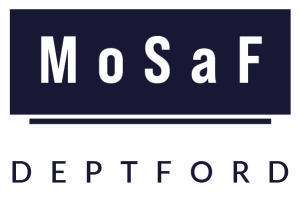Originally posted by Emily Finch on 853 London.
Deptford has a long naval history – but much of it is little talked about. EMILY FINCH met the local campaigners who want to tell the story of the area’s links with slavery.
On a cold winter’s morning in 1762, a teenage boy was forced off his master’s ship and sold back into slavery on the shores of the River Thames in Deptford.
There are no statues nearby recognising the life of Olaudah Equiano, who was trapped and traded like cargo just a stone’s throw from the gates of St Nicholas’ Church.
A team of former and current Deptford residents now hope to change this through the creation of the Museum of Slavery and Freedom (MoSaF) to mark Deptford’s role in the transatlantic slave trade.
“Why is there nothing on the shores of Deptford to say what happened here?” says Judith Hibbert, a committee member of the volunteer-led MoSaF team. Equiano would eventually raise enough money to pay for his freedom after decades of servitude. He settled in Westminster where he wrote his memoir which helped drive the early abolitionist movement through his vivid descriptions of slavery.
Hibbert, who grew up in Deptford, says she was taught very little at school of Britain’s role in the slave trade, which saw millions of people kidnapped from Africa by Europeans and enslaved in plantations in America and the Caribbean.
“We’re trying to get history told, from Deptford’s point of view. Far too often, it’s all about Greenwich and we’re forgotten about. This is where the transatlantic slave trade started and I don’t think a lot of people know that,” she adds.
Deptford’s history has been tied to Britain’s history of colonialism and slavery for centuries. Convoys Wharf, a now mostly-derelict 40 acre site by the river, was once the base of Captain John Hawkins when it was known as King’s Yard.
The naval commander is celebrated as the chief architect behind the defeat of the Spanish Armada during the reign of Queen Elizabeth I, but he also led numerous expeditions where people were captured and forced into slavery and later traded for sugar and pearls.
Since its transformation from a small fishing village to a royal dockyard – now Convoys Wharf – in the 16th century, Deptford has produced hundreds of ships for wars, trade and slavery. A large iron sculpture of an anchor at the entrance to Deptford High Street is one of the few obvious clues to its past.
Back by the Thames foreshore, outline plans from the Hong-Kong based CK Hutchison Holdings to develop Convoys Wharf into about 3,500 homes were called in and approved by the then-mayor of London, Boris Johnson, in 2013, over the head of Lewisham Council. Since then, the controversial development has been divided into 22 plots, with Lewisham rubber-stamping the detailed first stage of the developmentlast June.
Hibbert, alongside other members of the MoSaF team, hope their museum can be included in Convoys Wharf, or somewhere close by.
She says: “You need to know what happened in the past to improve things for the future. People need to know the struggles that some went through during the time of slavery, how people were traded for cotton and sugar, and the money people made from it.”
Before the pandemic, Hibbert visited the International Slavery Museum in Liverpool.
“In Liverpool, there’s no shying away from that history. It was an eye-opener for me,” says Hibbert. By 1740, Liverpool had surpassed London to become Britain’s slave-trading capital with around 100 ships leaving for Africa every year.
She hopes that their new museum would link up with others in Greenwich, and the Museum of London Docklands, so “people can go to Deptford and learn more”.
Hibbert adds: “We want to show the true light of what went on, but we don’t want to gravitate to just that. We want young people to get involved, we want to give them a focus. We learn so much about the Tudors at school but not much on slavery. This museum is about true history. Why should what we learn be one-sided?”
The team is still in the early stages of planning and are looking for more volunteers to help them decide which artefacts to include and whose stories need to be told. “We’re not saying that the museum is going to happen now, it will take years,” says Hibbert.
There are already two other groups vying for their projects to be built at Convoys Wharf. The Lenox Project, started in 2011 by a group of locals, aims to build and launch a replica of a 17th century naval ship from the wharf. Other residents have campaigned for the gardens of the 17th century diarist John Evelyn to be recreatedfollowing the discovery of garden walls by archaeologists from the Museum of London during a survey in 2013.
There has been a growing movement to publicly recognise Britain’s role in the transatlantic slave trade since the murder of George Floyd in the American city of Minneapolis last May. The death of the 46-year-old father at the hands of the police saw a resurgence in Black Lives Matter protests throughout the world. This culminated in protestors toppling a statue of Edward Colston – a 18th century merchant who profited from slavery – into Bristol harbour amid renewed calls for certain historical monuments connected to the slave trade to be removed from public display.
Closer to Deptford, red paint was thrown at the statues of three naval commanders enmeshed in the slave trade on the walls of the former Deptford Town Hall in New Cross Road.
“We want to put Deptford on the map as somewhere you can be proud of. We are trying to get as many people as possible interested in our aims,” says Hibbert. CK Hutchison Holdings has been approached for comment.
